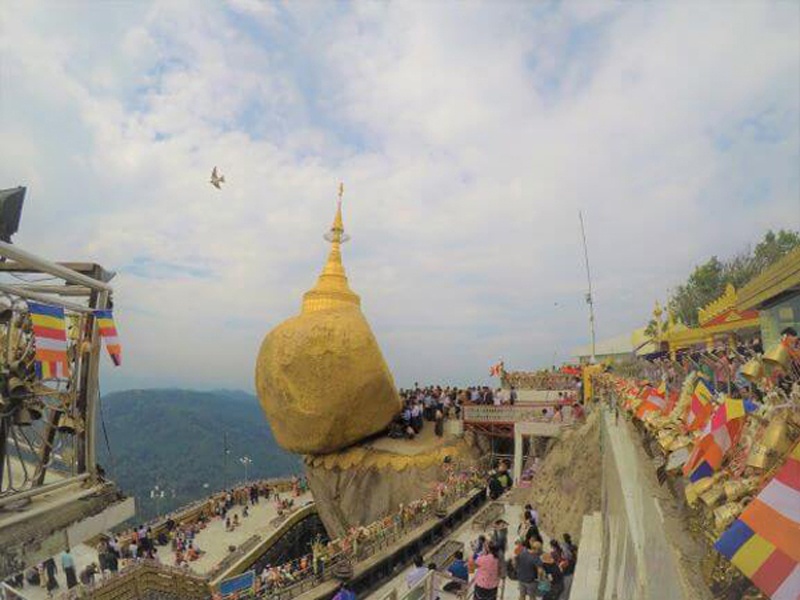Kyaikhtiyo Pagoda or the Golden Rock Pagoda is a well-known Buddhist pilgrimage site located on Mount Kyaikhtiyo a mountain standing 1.102 meters above the sea level in the Mon State, Myanmar, approximately 210 km from the city of Yangon (Rangoon) the old capital of the country.
It is a small pagoda of (7.3 meters) built on the top of a granite boulder covered with gold leaves which were pasted on by its male devotees. It is the third most important Buddhist pilgrimage site in Myanmar after the Shwedagon Pagoda and the Mahamuni Pagoda. The balancing rock seems to defy gravity, as it perpetually appears to be on the verge of rolling down the hill. The rock and the pagoda are at the top of Mt. Kyaikhtiyo. The paved mountain track, built in 1999, from the bus terminal at Yathaetaung, with kiosks on both sides is 1,2 km away from the holy rock takes about 1-hour walk (and climb). From the base camp at Kinpun, the hiking trek to the pagoda is about 11 km, and many devotees take this trek as a part of their pilgrimage rites.
The Pagoda was believed to be built more than 2500 years ago. According to the legend, the Golden Rock itself is precariously perched on a strand of the Buddha (Gautama)’s hair which was given to a hermit named Thaik Tha by the Buddha himself. The hermit, who had tucked the Buddha’s hair inside his hair tuft (knot), gave the hair to the king of Burma, with the wish that the hair to be enshrined on a rock shaped like his head. The king who inherited supernatural power from his father Zawgyi, a proficient alchemist, and his mother, a serpentine naga princess, used his power to find the right rock at the bottom of the sea and with the help of Thagyamin, the king of Tawadeintha Heaven in Buddhist cosmology, put it on mount Kyaikhtiyo using a magical boat. He then build a pagoda to enshrine the hair. In the Mon language, the word “Kyaik” means “pagoda”, and “Yo” means “to carry on one’s head”, while the word “Ithi” (Yathae in Burmese) means “hermit” in the Pali language. Therefore, the name Kyaik-Thi-Yo literally translates to “the pagoda carried on a hermit’s head”.
The boat which was used to move the rock from the sea in the legend is also believed to turned into stone, which also worshipped by pilgrim at a location about 300 meters from the golden rock. The boat stone is called as Kyaukthanban stupa (literally means “the Stone Boat Stupa”)
The rock is overhung by nearly half of it length on a sloping surface which drops down perpendicularly into the valley below. On the other hand, the rock table (tabular rock in the image above) is separated several meters away from the rest of the hill by a deep chasm, which now appended by a small footbridge. Women are forbidden to touch the holy rock and entering the inner sanctuary around it so they cannot cross the bridge.
By gently shaking the boulder, a thread can be passed through between it and the tabular rock. When viewed from a certain angle, this gaps can be seen by virtue of a thin beam of sunlight shining through it in the afternoon. A staircase leads to the pagoda complex that houses several viewing platforms, stupas, Buddhist and nats (spiritual beings worshipped by Myanmar people) shrine. A short distance away from the golden rock pagoda, there is a circle of gongs with four statues of nats and angels in the middle.
This rock has survived several violent earthquakes and stood stall for many centuries. The local population attributes this to the sacred hair relic of the Gautama Buddha enshrined inside the pagoda. Although small in size, this pagoda has been recognized as one of the wonders of Southeast Asia by the recent publication of Tourism Authorities in ASEAN.
The main square close to the golden rock has many establishments that sell religious paraphernalia and offerings for pilgrimage. In the adjoining area is the Potemkin village where visitors can find restaurants, gift shops, and guesthouses. As of late, a new terrace has been built at a lower level, from which visitors can get a good view of the golden rock pagoda.
Kyaikhtiyo Pagoda has become a popular pilgrimage and tourist attraction. At the peak of the pilgrimage season, from November to March, the precincts are flooded by visitors and pilgrims from all over Myanmar, including some foreign tourists. There are even devotees who are disabled and elderly walking up on crutches, or even carried on stretchers by porters to offer their prayers to the Buddha. In the Full Moon day of Tabaung, usually in March, the platform of the Pagoda shall be illuminated with ninety thousand, a truly marvelous sight to behold. (Richard).
